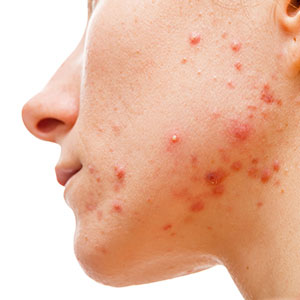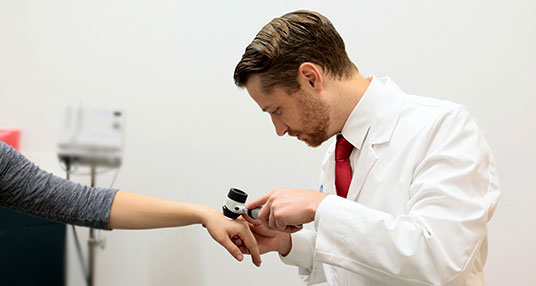
Acne
Acne is one of the most common skin problems in the world, affecting more than 45 million individuals in the United States alone. Although common, it is a serious, chronic disease and not just a simple adolescent condition. In fact, in 2016 the financial burden of acne was estimated to be $3 billion US dollars in healthcare costs and lost productivity. Moreover, acne carries with it not only a physical burden but an emotional and psychological one as well. It is the leading cause of visits to a dermatologist and can negatively affect your quality of life. Adolescents are at particular risk in this respect as acne can negatively impact body image, social engagement, and sexuality. In fact, severe acne is associated with increased depression, anxiety, poor self-image and poor self-esteem—even suicidal tendencies. Fortunately, our understanding of acne has improved greatly in recent years, and there are many ways to treat and manage it.
What is Acne?
Acne develops when pores—specifically, hair follicles—become clogged with oil and dead skin cells, forming what is known as comedones. These comedones eventually turn into small red bumps, or pimples, which can be characterized as blackheads, whiteheads, cysts, pustules, and more. Although acne commonly occurs on the face, it can also develop on the forehead, chest, upper back, and upper arms. Acne can affect people of any age, but it usually affects young teenagers. And while is more common and severe in males, it is more frequent and persistent in females.
What Causes Acne?
Hormones, diet, lifestyle and genetic factors are all thought to play a role in causing acne. But it is how these elements affect the hair follicle that matters. First is a change in the way that protein in the cells of the follicle is transformed into skin and nails (keratinization), which initially leads to the formation of comedones; next is increased production of sebum, an oily secretion of the sebaceous gland in the hair follicle; and finally colonization of the hair follicle by a bacteria known as Propionibacterium acnes. This bacteria activates the skin’s immune response, which leads to inflammation and the formation of papules, pustules, and cysts.
Do Foods Cause Acne?
For many years, certain foods were assumed to cause or worsen acne5. In particular, acne was linked to a Western diet high in hyperglycemic food and free fatty acids, as well as to dairy products, whey proteins, alcohol, tea, coffee, chocolate and salt. Although these foods may be triggers, further research is necessary to confirm this association. Factors other than daily food habits must also be considered, such as family history of acne, lifestyle or eating disorders, and body mass index, or BMI. Nonetheless, while the exact role between diet and acne isn’t fully understood, some foods may help prevent acne — particularly inflammation-fighting foods. Plant-based foods high in essential fatty acids may promote clearer skin. Omega-3 fatty acids may also decrease skin inflammation.
What is the Best Treatment for Acne?
Acne has recently been recognized as a chronic disease, and it should be managed as such4. But there are many treatments, which vary according to the type, stage, and severity of the acne. The most common treatments are listed below.
How Can I Clear Up Acne Fast?
There is no shortage of conventional wisdom on how to clear, shrink, stop, or kill pimples. You may read about applying ice, applying heat, or using natural herbs. Applying ice may temporarily reduce inflammation, and applying heat can encourage the pimple to “come to a head” and thus heal faster. But remember, acne is a complex skin condition. Picking at or popping lesions may aggravate the blemishes even more, as can overuse of products.
Are There Natural Remedies for Acne?
Many people distrust medications and prefer to turn to alternative acne treatments or herbs to treat acne. Often recommended are aloe vera, tea tree oil, witch hazel, manuka honey, tannins (fruit acids), and antiseptic, anti-inflammatory herbs such as calendula, chamomile, lavender, and rosemary. Some people may find such remedies effective, but professional dermatology groups advise caution. There can be unpleasant or harmful side effects to some remedies, including irritation, blisters, rashes, and more serious and long-lasting allergic reactions. Unless you are experienced in using herbal remedies, be sure to refer to credible sources on legitimate websites. Even better, discuss all potential treatments with your doctor or dermatologist.
Final Word on Acne
Acne is not to be taken lightly, and you do not have to wait until you “grow out of it.” If you or someone you know suffers from acne, remember that early intervention is the best way to treat and manage the condition. At Saguaro Dermatology, we understand the impact that acne can have, not just on your skin but also on your self-confidence. Our board-certified dermatologist, Dr. Dathan Hamann, and our caring and experienced staff are here to help.
Saguaro Dermatology Reviews

Wendy L.
I had an awesome experience with Dr Hamann and staff. I was very comfortable and i was able to have all my questions answered without feeling rushed. The staff was courteous and welcoming.

Itaro Elaisa
“I totally recommend this place to anyone who’s looking for a dermatologist who’s professional, informative, respectful and very helpful. They are quick to solve your problems and get you home.”

Robert P.
Staff was friendly, & on time. office is super clean!! Doctor was awesome, felt like a family member taking care of me.

Kristin U
“Dr Dathan and the team were very helpful, kind and knowledgeable. Plus, there was no wait time so I was able to get back to work faster than expected. I would highly recommend.”

Sally S.
“Very friendly and professional. I had a great experience, Dr. Hamann was very good at answering my questions and concerns. I will certainly come back for another visit.”

Amanda C.
Great doctor and friendly, professional staff. The doctor spends time listening and answering questions, something rare to find anymore. The office is beautiful and very clean. I love all the artwork with saguaros.

Kylin L.
“The office was recently renovated–it is a beautiful, clean, and calm environment. I would highly recommend this practice for anyone who is looking for a general dermatologist.”

L
Dr. Hamann is very knowledgeable, nice, and professional. You can tell that he truly cares about his patients by the way he operates. He took the time to listen to all of my concerns then address them with good, well-informed answers.

About Saguaro Dermatology
Our comprehensive dermatology clinic is dedicated to providing you with the highest quality of care, innovative practices, helpful resources and state-of-the-art technology to prevent and treat a multitude of skin disorders. Led by Carsten R. Hamann, MD, PhD, Dathan Hamann, MD, FAAD, Michael McBride, DO, Millard Thaler, MD, Mohs Surgeon and Jenna Wald, MD, Mohs Surgeon, our passionate team looks forward to serving you with respect and compassion.
 Ahwatukee
Ahwatukee




